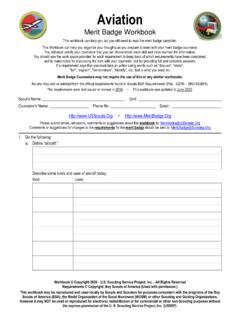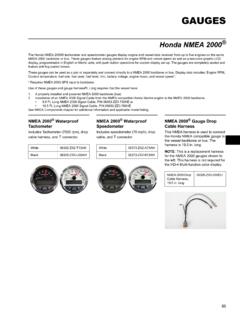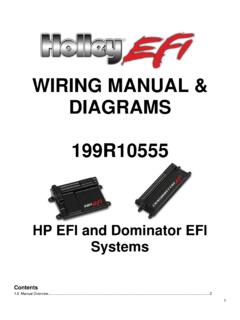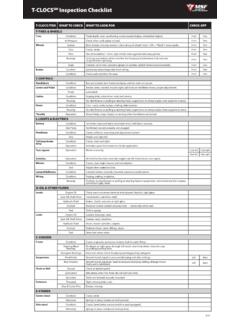Transcription of Traditional Electric Gauge - Stewart Warner
1 434956 Rev 2: 04/30/18 Installation Instructions Electric Gauges 2-1/16 and 2-5/8 1 PRECAUTIONS: Read ALL instructions before installing instrument. Follow ALL safety precautions when working on vehicle-wear safety glasses! ALWAYS disconnect (-) negative battery cable before making electrical connections. HELP?: If after reading these instructions you don t fully understand how to install your instrument(s), contact your local Stewart Warner distributor, or contact our Technical Support Team toll free at 1-800-676-1837 Additional applications information may be found at GENERAL APPLICATION: 12-volt DC negative (-) ground electrical systems (11-16 VDC operating voltage range for the Gauge , 11-16 VDC for the Light bulb). 2 Gauge MOUNTING (Figure 1): Recommended panel cut-out (hole size) for 2-1/16 instruments is 2-1/16 and 2-5/8 instruments is 2-5/8 . Secure the Gauge in the hole using the supplied bracket and nuts.
2 3 SENDER INSTALLATION TIPS/CAUTIONS: Sender is grounded through its threads to the engine. DO NOT use sealing tape on threads. Instead, use a thread sealing compound to prevent leaks. When installing this Gauge , DO NOT remove existing factory-installed senders ( on engine); use an alternate location or port. Computer controlled engines may trigger a fault code (check engine light) if the factory senders are removed. Consult a factory technician for help. Disconnect negative (-) battery cable before making electrical connections. Incorrect wiring may damage sender or cause personal injury. Stewart Warner Performance recommends that qualified automotive technicians perform installations. NOTE: Use a grommet when passing wires through firewall to prevent wires from being damaged. NOTE: Any wire that supplies 12V (ignition, switched, constant, etc.) should be properly FUSED (recommended fuse sizing: 1 amp fuse for a single Gauge , 10 amp fuse for a full set) to prevent damage to instruments, or a vehicle fire if wire is short-circuited.
3 EQUIPMENT: 18- Gauge wire Red eye crimp connectors Wire crimper/cutter 4 PRESSURE Gauge WIRING (Figure 2): 1. Disconnect negative (-) battery cable. 2. Using 18-ga. wire, connect the (G) terminal to a clean (rust/paint-free) engine ground near the oil pressure sender. 3. Using 18-ga. wire, connect the (I) terminal to a switched +12V source. 4. Using 18-ga. wire, connect the (S) sender terminal of the Gauge to the pressure sender. 5. Connect the light wire to the dash lighting circuit or to a +12V switched circuit. 6. Double check all connections then reconnect the negative (-) battery cable & test instrument to ensure that it is working. PRESSURE SENDER INSTALLATION: Install pressure sender in appropriate pressure port. Use a wrench on the hex portion of the sender to tighten. If sender is used in a high-vibration environment such as a full race engine, it is recommended to isolate the sender by remotely mounting it to the firewall or fender well.
4 Some installations may require an adapter bushing. See catalog or web site for adapters. 5 6 Figure 2 Figure 1 TEMPERATURE Gauge WIRING (Figure 3): 1. Disconnect negative (-) battery cable. 2. Using 18-ga. wire, connect the (G) terminal to a clean (rust/paint-free) ground surface near the temperature sender. 3. Using 18-ga. wire, connect the (I) terminal to a switched +12V source. 4. Using 18-ga. wire, connect the (S) sender terminal of the Gauge to the temperature sender. 5. Connect one the light wire to the dash lighting circuit or to a +12V switched circuit. 6. Double check all connections then reconnect the negative (-) battery cable & test instrument to ensure that it is working. TEMPERATURE SENDER INSTALLATION: Install Temperature sender in appropriate water, engine oil, or transmission oil port. Use a wrench on the hex portion of the sender to tighten. When installing temperature sender, be sure there is sufficient clearance in the port so the sender is not damaged when it is tightened or by internal moving parts.
5 If the sender is to be used in an oil pan where there is no port, drill a hole, braze an adapter into the oil pan, and install the sender in the adapter. 7 8 fuel LEVEL Gauge WIRING (Figure 4): 1. Disconnect negative (-) battery cable. 2. Using 18-ga. wire, connect the (G) terminal to a clean (rust/paint-free) ground. 3. Using 18 Gauge wire, connect the (I) terminal to a switched +12V source. 4. Using 18- Gauge wire, connect the (S) sender terminal of the Gauge to the fuel level sender. 5. Connect one the light wire to the dash lighting circuit or to a +12V switched circuit. 6. Double check all connections then reconnect the negative (-) battery cable & test instrument to ensure it is working. 9 10 VOLTMETER WIRING (Figure 5): 1. Using 18-ga. wire, connect the (G) terminal to a clean (rust/paint-free) ground. 2. Using 18 Gauge wire, connect the (I) terminal to a switched +12V source; this is the voltage that the Gauge will indicate.
6 3. Connect one the light wire to the dash lighting circuit or to a +12V switched circuit. 4. Double check all connections then reconnect the negative (-) battery cable & test instrument to ensure that it is working. 11 CLEANING DIRECTIONS: For proper cleaning of instrumentation/accessories, use a glass cleaner or mild detergent with a spray on and wipe method. WARRANTY INFORMATION: TWO (2) YEAR LIMITED WARRANTY. Stewart Warner products are warranted against defects in workmanship and materials for a period of two (2) years from the date of purchase. Proof-of-purchase is required; otherwise, the warranty period shall default to two (2) years from date-of-manufacture (as indicated by the date code on the product). See detailed Warranty Policy for other Terms & Conditions. Stewart Warner 1-800-676-1837 12 Figure 3 Figure 3 Figure 4 Figure 3 Figure 5





